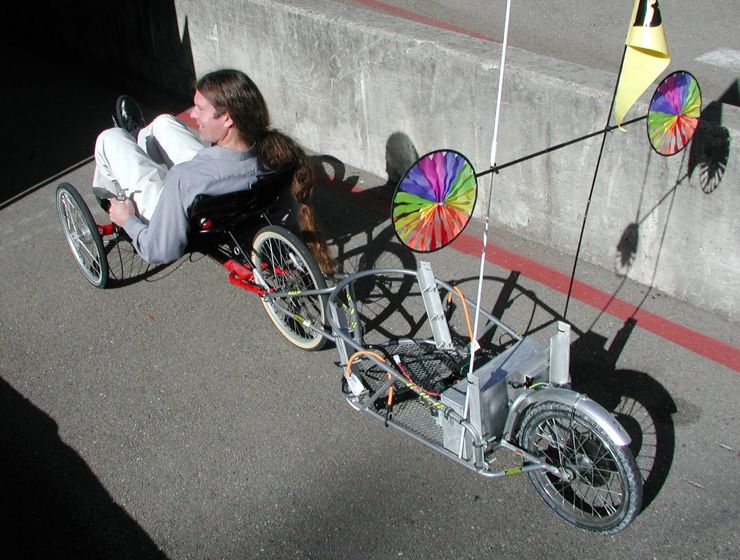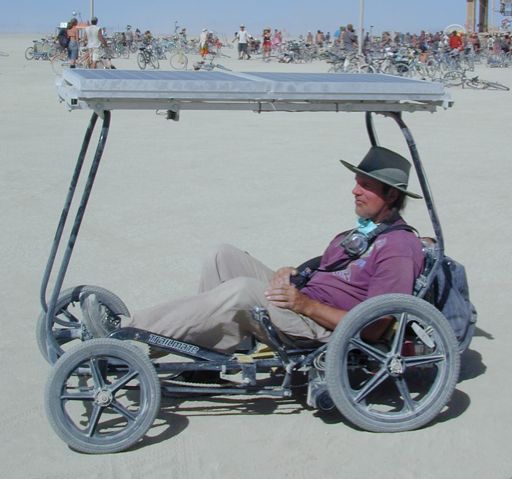EXPERIMENT ONE: A CRUDE FOUR-WHEEL PLAYA CRUISER

After a decade of speculating about the practicality of building a solar-powered desert vehicle, in 1996 Bryan found an old four-wheeled pedal contraption for sale in Sacramento. Called the ‘Rhoades Car,’ it was originally designed to have two riders pedal it around senior complexes. Could it be used as the frame for a possible desert solar vehicle?
We went into high gear with the goal of building something we could take to the Burning Man arts festival in that same Black Rock desert where we first dreamed of solar playa vehicles. So we built a frame out of bent electrical conduit to hold some solar panels above the car, and outfitted it with a scrounged one-half horsepower motor connected to the rear axle through two stages of chain reduction. The motor was a brushed DC motor made for water pumps. We used industrial chain, sprockets and bearings, which was a mistake because of the large frictional losses. The Rhoades Car had two cranks in front, driving two chains to derailleurs in back. We added a third sprocket cluster and derailleur to the rear axle, though we never implemented gear changing on the driven cluster.
The electrical system was 12 Volt, with two marine batteries in parallel. Solar power came from an array of nine 36-Watt Carrizo Solar panels once used on the Arco solar array on the Carrizo plain in California. This 300W array charged the batteries directly with no controller. On a sunny morning we would see with delight that the panels were pushing 20 amps into the battery. On a sunny afternoon we could hear the electrolyte boiling inside. Hmmm...maybe it’s time to stop charging?
We also opted to design our own motor “controller,” an on-off switch rather than an actual speed controller. We would pedal up to our maximum endurable speed, then cut in the motor. Yabba-dabba-doo!
Our motor switching was accomplished with a bank of FETs activated by a switch on the steering wheel. The FETs were high power, low resistance devices which remained cool since they didn’t have to do much. We also replaced the original wimpy manual disk brake with a hydraulic brake used in go-karts, and energized it using a motorcycle master cylinder. The whole lumbering thing weighed about 600 pounds empty, closer to 1,000 with the two of us. It had a top speed on smooth pavement of 12 miles per hour, at about 60 Amps draw, though up to 100 amps when accelerating. We couldn’t be sure, however, because the mighty arcing current melted the 30 amp ammeter.
To Bryan, high current implied knife switches as controls, in the style of Nicola Tesla and Dr. Frankenstein. We installed a knife switch above Russell’s head as an emergency shutoff, connected via stiff 6 gauge wire to the battery terminals. On a side trip to a hot spring in 1997, the wires jiggled until they fatigued and broke, showering Russell with green sparks. He had to manually hold the wires on the terminals while bouncing along on the dirt road, hoping to wash the soot off himself in the spring.
Russ was seen underneath the vehicle half the time, wielding soldering irons to repair flamed-out circuits. This vehicle went to Burning Man for three years, after which the frustration/fun ratio exceeded unity.
EXPERIMENT TWO: A SMALLER QUADRACYCLE WITH PUSHER TRAILER

It was clear that putting solar panels on wheeled vehicles made more sense when applied to lighter vehicles. As the whole system scales down, the weight and therefore the power required decreases as the cube of the scaling factor, but the solar power decreases as the square. You win if the system gets smaller. Thus a vehicle half the size may have a quarter of the solar, but an eighth of the required power. Little toys about two inches long powered only by a small array of cells on top zip along quite nicely. Clearly, as the size is decreased, the ratio between operating power and solar panel power decreases, so you can charge for less time between runs, and even run all day without having to charge (when the ratio is 1). One can use this run/charge power ratio as a design goal. For instance, if you expect to charge four times as long as you run, then a 100W panel with a 400W motor is about right. Of course there are inefficiencies and variations in available sun that aren’t taken into account in this simple approach, but this has been the rule of thumb for the design of the cars from the beginning, and it seems to work. The ratio we try to maintain is 4:1 or less, which is convenient for use at Burning Man, where one stops frequently to look at art.
Consequently, Russell decided to build a much-lighter, single person vehicle based on a four-wheel car from Trailmate, the Xcelerator. Trailmate builds indestructible pedal cars and trikes for bike trails near tourist attractions like Venice Beach, so these could withstand the Burning Man environs. To power it, Russell bought a pusher trailer made by Thunderstruck EV in Sonoma CA. This was a Bob Yak trailer with a 400W motor connected to the wheel with a chain. It freewheeled when not powered. The 24V brushless DC motor was powered by two 16AH gel cells in series. This trailer was designed to connect to any bike rear axle via a special axle with side pins, and so could be attached to any bike. Russell used it for his recumbent Terratrike commuting to work, enough to fry the motor on hills. Eventually the motor was replaced with a larger version.

A 100W solar panel (recovered from the Rhoades Car project) was used as the power source, mounted on the trailer. This was a 12V source, so charging was implemented through a 12V controller using a switch to charge the batteries in parallel and discharge them in series. When the vehicle was stopped, one flipped the switch from run mode at 24V to charge at 12V. This solar trailer pushed the Trailmate car at about 14MPH. It was a truly useful vehicle with some carrying capacity in the trailer.
The vehicle evolved in subsequent years. A second panel was added on a frame above the Xcelerator pedal car, boosting the solar power to 200W. This allowed series operation at 24V and constant charging of the batteries through a 24V controller. A volt meter above the driver’s head on the overhead panel monitored the state of charge. As the pusher trailer acquired more mileage, the frame began to give out in back due to the asymmetrically mounted motor and the weakness of the aluminum frame, which was bouncing along with batteries and a 25 pound panel to boot. The bouncy Yak was not as good a choice for this as the Bob Ibex, which has suspension, and which was the basis for an evolved design by Thunderstruck (using a hub motor) before they abandoned this product altogether. It has been completely redesigned by Synthetic Transport, using a specially built trailer and lithium batteries.
Another problem on the playa was the accumulation of dust in the chain, causing wear and lengthening. The chain was tensioned by adjustment of motor-wheel separation, and would lose tension when ground out by dust, causing the chain to pop off. This was exacerbated by twisting of the frame due to the problems mentioned above.
EXPERIMENT THREE: CHAIN-DRIVEN QUADRACYCLE

Finally the trailer version of the vehicle was abandoned altogether and a motor was mounted on the Xcelerator itself. This new iteration used a Cyclone drive system, designed to drive the chain on a regular bike. Really nothing more than an industrial brushless DC motor with a gear reducer and a freewheel sprocket, this was mounted on the bottom of the frame to drive the chain to the rear wheel. The Xcelerator is designed with a front chain connected to the crank, coupled to a rear chain to the wheel through a freewheel hub for a cruiser bike. This in combination with the Cyclone freewheel made pedaling and motoring independent.
The 12V, 100W overhead panel was replaced with two 12V, 50W panels in series. This made a nice compact vehicle every bit as useful as the previous ones. The main problem was the dust grinding, chain lengthening issue, as there was no spring idler to tension the chain. One has to carefully design these systems for the harsh environment on the playa.
EXPERIMENT FOUR: A HUB MOTOR DELTA TRIKE


Russell developed an alternate design based on hub motor power. Taking again a Trailmate base vehicle, the Low Rider, he put in a Crystalyte 406 motor in the 16” front wheel of this delta trike. The 406, run on 36 volts, he calculated, would give a maximum ground speed just sufficient for desert playa operation. The pedals drive one rear wheel, so motor and pedals are independent. To get the 36 volts the motor requires, Russell developed a charger that would take 12V from a panel and charge a bank of three 18AH gel cells. This was a set of magnetic latching relays sequenced from a digital counter, which applied power from the 12V charge controller to each battery in turn, 10 seconds per battery. This may not be the perfect way to treat the batteries, but it worked. There is a 12V, 85W panel (Kyocera) on a frame on top. This machine runs at 16MPH on flat pavement. A planned improvement is to replace the relay contraption with a DC-to-DC converter to 36V, and use a 36V charge controller. This vehicle was intended to be a design that could be built cheaply and easily. It has proved to be more reliable than the Xcelerator version, when run in identical conditions
By 2007, then, Russ and Bryan had experimental experience with building four solar vehicles and were eager to press on to their fifth and most-ambitious project, the Solar Touring Bike.